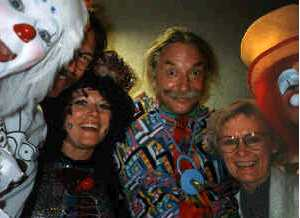 I had to call Betty. I hadn’t talked to her in a while. I had met Betty a few years ago when I toured her factory in Hollidaysburg, Pa., a blip of a town tucked into the folds of the Allegheny Mountains. Betty’s factory, James Industries, is where the world-famous Slinky is made. Betty’s husband, Richard, invented the Slinky 51 years ago. Betty came up with the name. At 77, she’s still running the company.
I had to call Betty. I hadn’t talked to her in a while. I had met Betty a few years ago when I toured her factory in Hollidaysburg, Pa., a blip of a town tucked into the folds of the Allegheny Mountains. Betty’s factory, James Industries, is where the world-famous Slinky is made. Betty’s husband, Richard, invented the Slinky 51 years ago. Betty came up with the name. At 77, she’s still running the company.
As soon as I met Betty I wanted to adopt her as a hero. So I did.
Anyway, I needed to call her because I was worried. I had just read an Associated Press news story about Betty and her Slinky family. Particularly the Slinky dog, which made it to the big screen in “Toy Story.” Good Movie. Great movie, in fact. People went nuts. People rushed right out and bought talking Buzz Lightyears, stuffed Woody the Cowboys, special edition Mr. Potato Heads. All the toys from the movie sold like crazy over Christmas.
Except the Slinky dog. Why not the Slinky dog? Because it wasn’t available.
Shame on the company. That was the tone of the Associated Press news story.
As if Betty James had committed a mortal sin against merchandising. How could any self- respecting business miss out on its one chance to profit from a trend handed down by Hollywood itself? A toy industry analyst was quoted as saying, “When Disney is ready to roll, you’d better be ready too.”
I thought, Poor Betty. I wondered if she was all curled up in a ball of public embarrassment. So I called her, feeling the way you do when offering condolences to a friend.
What happened? I asked.
“Mold Troubles,” she said. The original Slinky dog had been out of production for about five years, and she wanted the new one to look exactly like the one in the movie. “And oh, it is cute,” she said. “Wait till you see it. It’s tan with a yellow snout.” She said the dog should hit stores by the end of this month.
Wasn’t she upset about missing out on the zillions of dollars that the dog could have brought in?
Was she upset she didn’t get it out for Christmas?
“I feel bad for the children,” she said. “But they’ll get it in time.”
I thought: children? I said: “I mean aren’t you upset that you missed out on the buying hysteria associated with the movie?”
“Oh, these people are working very hard,” she said. “I can’t get upset with them.”
I thought: people? I’m talking profits here. Wasn’t she upset about missing out on the zillions of dollars that the dog could have brought in?
“Oh that.” She laughed. “I can’t get upset about those things. Really, dear. Life is much too short.”
I thought: Duh. And I remembered what it was about Betty James that had so captivated me in the first place.
Growing up, all she ever wanted was a family. She fell in love with Richard, got married and had six kids. Richard, an engineer, invented the Slinky, made a lot of money. Life was good.
She could have caved in. But she didn’t.
But then Richard met some strange people. One day in 1960, he announced he was up and moving to Bolivia. He had joined a religious cult, had handed over a lot of money to it. He left Betty with a bankrupt company, six kids and a shattered heart.
She could have caved in. But she didn’t. She paid off the bills within four years, sending along thank you notes to people for waiting so long. And more than that, she ran a business with a heart.
James Industries became quite profitable. Toy conglomerates offered to buy the Slinky from Betty. “Oh, I was wooed by some of the best,” she would say. “And if I sold, I’d be much better off now. Much better.” But she didn’t. She refused to close the factory. “How could I turn my back on the people who had helped me survive?”
Even now, she could do a lot of things to increase profits. She could downsize. She could outsource to some country with cheap labor. She could make the Slinky smaller, or out of cheaper steel. But she doesn’t. “Slinky is like your child, and you don’t exploit your child.”
In 1945, a Slinky cost $1. You can still get one for less than $2. “My theory is, if it’s a child’s toy, make it affordable.”
I asked her if she’d read the AP news story about the Slinky dog. “It was silly, wasn’t it?” she said. “Honestly, if it was good news they wouldn’t have taken the time.”
Then we drifted off the subject. We caught up. She told me that her two old Yorkies, Mork and Mindy, finally died.
I told her I got a new dog, too. My dog’s name is Betty. I wasn’t aware I was naming her after anybody. It’s funny the way heroes just get into your system.
(Used with kind permission of Jeanne Marie Laskas – January 28, 1996, the Washington Post Magazine)
 President Clinton pushed for an agreement and finally got one between Israeli Prime Minister Benjamin Netanyahu and Palestinian Authority President Yasir Arafat after nine days of sometimes all-night negotiations with Clinton and Jordon’s King Hussein offering a final push at the secluded Wye River Plantation on Maryland’s Chesapeake Bay.
President Clinton pushed for an agreement and finally got one between Israeli Prime Minister Benjamin Netanyahu and Palestinian Authority President Yasir Arafat after nine days of sometimes all-night negotiations with Clinton and Jordon’s King Hussein offering a final push at the secluded Wye River Plantation on Maryland’s Chesapeake Bay.
































 When Bill Thomas graduated from Harvard Medical School he had no intention of working in a nursing home — too depressing. “I went out of my way to avoid nursing homes,” says Dr. Thomas.
When Bill Thomas graduated from Harvard Medical School he had no intention of working in a nursing home — too depressing. “I went out of my way to avoid nursing homes,” says Dr. Thomas.



